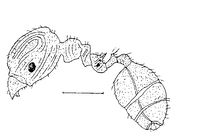Pheidole bandata
| Pheidole bandata | |
|---|---|

| |
| Scientific classification | |
| Kingdom: | Animalia |
| Phylum: | Arthropoda |
| Class: | Insecta |
| Order: | Hymenoptera |
| Family: | Formicidae |
| Subfamily: | Myrmicinae |
| Tribe: | Attini |
| Genus: | Pheidole |
| Species: | P. bandata |
| Binomial name | |
| Pheidole bandata Bharti, 2004 | |
Collected from a nest in the soil; pupae were also collected.
Identification
Bharti (2004) - Pheidole bandata differs remarkably from all other species of this genus described from the Oriental region on the basis of the following combination of characters (which are distinct for this species): antennal scrobes broad and shallow: occiput punctured, not rugulose; whole alitrunk transversly rugose; propodeal spines much longer than in other species; gaster finely punctate from base to apex; prominent yellow bands on gaster. However it is related to Pheidole nietneri, but can be easily distinguished from the latter by; head longitudinally striate up to vertex in nietneri; but transversely striate on lateral lobes in bandata; posterior portion of head smooth and shining in nietneri, finely punctate in bandata; anterior margin of clypeus transverse in nietneri, incised in middle in bandata; gaster smooth and shining in nietneri, finely punctured in bandata; petiole rounded above in nietneri, transverse in bandata. The minors of two species also differ remarkably as; pronotum smooth, mesonotum with shallow punctures, gaster shining in nietneri, but finely punctate in bandata.
Distribution
Distribution based on Regional Taxon Lists
Oriental Region: India (type locality).
Distribution based on AntMaps
Distribution based on AntWeb specimens
Check data from AntWeb
Countries Occupied
| Number of countries occupied by this species based on AntWiki Regional Taxon Lists. In general, fewer countries occupied indicates a narrower range, while more countries indicates a more widespread species. |

|
Estimated Abundance
| Relative abundance based on number of AntMaps records per species (this species within the purple bar). Fewer records (to the left) indicates a less abundant/encountered species while more records (to the right) indicates more abundant/encountered species. |

|
Biology
Castes
Nomenclature
The following information is derived from Barry Bolton's Online Catalogue of the Ants of the World.
- bandata. Pheidole bandatus Bharti, 2004: 305, figs. 1-6 (s.w.) INDIA.
Unless otherwise noted the text for the remainder of this section is reported from the publication that includes the original description.
Description
Worker
Holotype. (major) Length 4.62 mm; head length 1.32 mm; head width 1.15 mm; scape length 0.82 mm; scape index 71.30; eye diameter 0.19 mm; pronotal width 0.66 mm; alitrunk length 1.15 mm; cephalic index 87.12; mandibular index 37.12.
Head. Little longer than broad, converging slightly in posterior part; occipital emargination not deep; posterior margin of lateral lobes almost flat; mandibles with two apical teeth; antenna! club formed by 3 apical segments, which are much longer than preceding ones; antennal scrobes reaching up to length of scape, broad and shallow; scape crosses more than half of head, short of posterior margin of head by 2/5th its length; eyes situated below midline of head; frontal carinae cover bases of antennae, diverging posteriorly; clypeus with anterior margin incised in the middle, posterior margin extending in between frontal carinae; clypeus elevated at middle with faint carina in anterior half touching its incision; head rugulose with longitudinal rugae, which curve outward in front of lateral lobes, turn downwards toward anterior side of head; occiput not rugulose, punctured; area between rugae and antennal scrobes finely punctured; clypeus and mandibles finely punctate; whole head covered with pale hairs.
Alitrunk, petiole and postpetiole. Pronotum with distinct lateral tubercles; mesonotal furrow deep and wide, followed by distinct transverse ridge; metanotal groove deep and distinct; propodeum laterally bordered, with long acute spines (at almost 45° in profile); propodeal base truncate in profile, declivity very oblique; petiole with long peduncle without appendix, its upper margin transverse, narrowing anteriorly in front view, diverging into short blunt margins; postpetiole acutely conical along lateral margins, very broadly joined to gaster, its upper margin rounded; petiole and postpetiole, 1:2; postpetiole broader than long (2: 1); whole alitrunk transversly rugulose, finely punctate; petiole, postpetiole finely punctate with few indistinct transverse rugae on posterior margin of postpetiole: ali trunk, petiole, postpetiole, legs covered with scattered long pale hairs.
Gaster. Broadly elongate; very densely and finely punctate from base to apex; covered with long decumbent hairs.
Head, alitrunk, petiole, postpetiole reddish brown; antennae and legs with a paler shade; gaster dark brown to black with apical margins having yellow bands; these bands are also prominent on lateral side of gaster.
Paratype. (minor) Length 2.64 mm; head length 0.49 mm; head width 0.49 mm; scape length 0.66 mm; scape index 134.6; eye diameter 0.11 mm; pronotal width 0.33 mm; alitrunk length 0.82 mm; cephalic index 100; mandibular index 48.97.
Head oval, as long as broad; mandibles with 3rd tooth reduced and smaller than the 4th; scape long extending by 1/3rd of its length from top of head; eyes almost at mid-length of head; pronotum tuberculate; propodeal spines short but acute; petiole without appendage; postpetiole not conical along lateral margins, slightly broader than long (1.6: 1.3); petiole breadth of postpetiole, 1:1.5; head, alitrunk, petiole, postpetiole, gaster finely punctate with few rugae on cheeks; head and gaster dark brown, other parts brown; the rest like in the major worker.
Type Material
Holotype: Worker (major); India, Dunera, Himachal Pradesh; 700 m a.s.l., 8.03.2000; Bharti, H. Paratypes: 10 major workers, 20 minor ones with same data as those of holotype. The holotype of the new species shall be deposited in IARI (Indian Agriculture Research Institute, National Collections) PUSA New Delhi, after the publishion of this paper.
Etymology
The species is named due to presence of prominent yellow bands on gaster.

